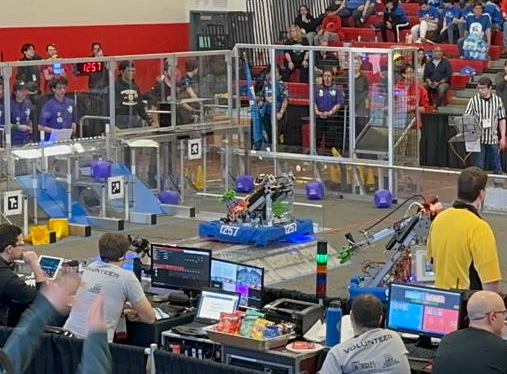On April 19, the FIRST Robotics Competition’s (FRC) world championship kicked off in Houston, Texas. Hundreds of robotics teams flew to Houston from around the world to participate in this three-day competition to crown the FRC world champion. But before these teams could get to this point, they had to prove their robot’s worth in numerous district and regional competitions. Like any other sport, FRC requires teams to spend countless hours practicing and perfecting their craft, with many members spending over 10 hours a week with the team.
FIRST (For Inspiration and Recognition of Science and Technology) is a non-profit organization that aims to inspire young people to be science and technology leaders. The FIRST Robotics Competition (FRC), one of the programs run by FIRST, is an annual worldwide robotics competition in which teams of high school-aged youth design and build robots that compete with other teams to complete a set of prescribed tasks. The competition combines the excitement of sport with the rigors of science and technology.
These competitions bring together teams of high school students from around the world to design, build, and program robots to compete in the same challenge. These challenges are designed to be both fun and challenging, and they require teams to work collaboratively, think critically, and solve problems under pressure. This year’s challenge is to manipulate cones and cubes to score them in a designated scoring area and balance on a shifting platform.
Although it is a robotics competition, FRC is not just about making robots; teams need to work in multiple areas in order to create a well-rounded team. Typically, teams can have between twenty to a hundred members. Each team member contributes their unique skills and talents to the team, which may include programming, electrical engineering, mechanical engineering, and project management. To keep the team operational, teams need to have departments dedicated to different aspects of the team’s operation since there are too many tasks for any one person to handle. The Build department is responsible for designing and building the robot, while the Electronics department handles the robot’s electrical components. The Programming department writes the code that controls the robot, while the Strategy department develops game strategies and makes decisions during competition. Teams also need to have strong communication and collaboration skills, as well as the ability to think creatively and problem-solve under pressure. Communication is integral in the robot building and troubleshooting process between these parts of the team to create a functioning robot from the beginning of January by the competition deadline in March.
Running a robotics team is not cheap: registration costs to enter competitions are several thousand dollars. The Business and Accounting departments exist to manage the team’s many expenditures, including registration fees, robot parts, team shirts, bus costs, etc. The Marketing department works to promote the team on social media to make it look attractive to potential sponsors, ranging from local small businesses to large corporations. These sponsorships are an important source of funding for teams, especially those that don’t get money from their school districts. Most successful teams have yearly budgets of around forty thousand dollars so the onus is on these departments to provide the resources that the rest of the team needs to create the robot.
Having outreach programs, such as robot showcases or other community events, is also crucial for robotics teams. These programs provide opportunities for teams to connect with their communities and promote STEM education; these interactions can nominate these teams for awards at the competition. They also allow teams to showcase their work and inspire others to become involved in robotics. Additionally, outreach programs provide valuable experience for team members in communication, teamwork, and leadership skills with those in the community. By participating in outreach programs, teams can also develop partnerships with local businesses and organizations, which can lead to additional funding and resources for the team. Overall, outreach programs are essential for building strong relationships between robotics teams and their communities, while also providing opportunities for personal and professional growth for team members. For example, a group of FRC teams in the area (along with 1257) are hosting an event at Bridgewater Commons from September 30th to October 1st to put their robots on display. This event, named the Raritan Valley Science and Technology Showcase, connects the many FRC teams in the area to the public and potential sponsors in the mall.
Participating in FRC can also be highly beneficial for students in terms of their college and career goals. Many colleges and universities recognize the value of FRC participation and offer scholarships or preferential admissions consideration for FRC participants. Additionally, FRC provides opportunities for students to network with professionals in the STEM fields, gain valuable experience and insight into potential career paths, and build a strong resumé for future job applications. The skills developed through FRC are highly transferable, making FRC a valuable experience for students looking to pursue careers in STEM fields or beyond!
UCVTS has its own FRC team, Team 1257, Parallel Universe. This team provides the opportunity for the bright students of our district to compete with many large schools outside of Union County, almost like a sports team. With over a hundred members, the students from UCVTS run a fully functioning FRC team. The team not only teaches students applicable skills in the fields they want to pursue but also gives them the chance to meet new people from around UCVTS, throughout New Jersey, and around the world who have similar interests. Robotics competitions are high-energy, fast-paced events that are designed by FIRST to be engaging and exciting for participants and spectators alike. The sense of camaraderie and sportsmanship that is fostered at the competition is truly inspiring, and it is a testament to the positive impact that FRC is having on young people around the world.
You can be inspired as well by joining the UCVTS robotics team! Google classroom code: xxyy5qz
Image Citation
Team 1257. “End of the Autonomous Period in a Qualification Match.” Google Drive, 1 April 2023, Image. Accessed 18 April 2023.

 The Fashion Industrys Not-So-Secret Impact
The Fashion Industrys Not-So-Secret Impact